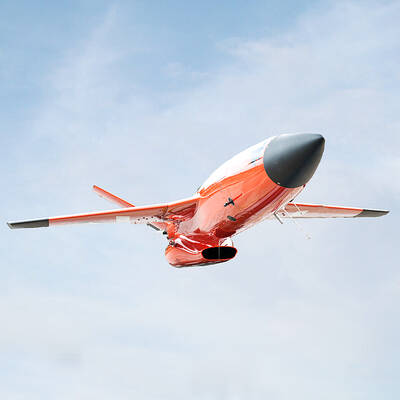The Ministry of National Defense yesterday unveiled its biennial white paper on national defense, outlining doctrinal changes that emphasize asymmetric warfare and layered defense.
The 2017 National Defense Report reiterates the military’s commitment to an all-volunteer force and the indigenous development of military aircraft and warships.
“We are cognizant that our nation cannot compare with the defense budget and military development in China, whose military’s pace of growth and strength have far exceeded expectations,” Minister of National Defense Feng Shih-kuan (馮世寬) said in the report.

Photo: Huang Yao-cheng, Taipei Times
“Consequently, we must employ vision and foresight in our adjustment of defense concepts and overall armament development,” he said.
China has acquired the ability to execute long-range sea and air operations, and it is pushing the reach of its force projection to the areas west of the second island chain, the report said.
The second island chain refers to Japan’s Bonin Islands and Volcano Islands, and the US’ Mariana Islands.
Those developments necessitate a change in the nation’s strategy from “strong defense and effective deterrence” — which had been in effect since 2009 — to “strong defense and layered deterrence,” the report said.
Strong defense refers to in-depth defense, improving combat sustainability, protecting command and control infrastructure from cyberthreats, and developing strategic endurance, it said.
Layered deterrence involves using “innovative and asymmetrical warfare” that confronts the enemy with multiple dilemmas to achieve deterrence, it said.
The overall military strategy in a defensive war is to achieve “force preservation, win decisive battles in littoral waters and annihilate the enemy on the beachhead,” the report said.
It is desirable for the military to acquire precision-guided munitions, electronic countermeasures, guided anti-tank missiles, man-portable air defense systems, fast multiple-role warships, uncrewed aerial vehicles and naval minelaying capabilities, among others, the report said.
The report listed Chinese air and sea drills conducted between Aug. 18 last year and Dec. 11, including 23 air patrols and two aircraft carrier exercises in proximity to Taiwan’s territorial waters or air defense identification zone.
The ministry will stop giving news briefings on ongoing Chinese military exercises near Taiwan, ministry spokesman Major General Chen Chung-chi (陳中吉) told a news conference in Taipei.
“When Chinese aircraft and ships are not posing any more threat to us than usual, we see no need to help them with their propaganda,” he said.

CROSS-STRAIT COLLABORATION: The new KMT chairwoman expressed interest in meeting the Chinese president from the start, but she’ll have to pay to get in Beijing allegedly agreed to let Chinese Nationalist Party (KMT) Chairwoman Cheng Li-wun (鄭麗文) meet with Chinese President Xi Jinping (習近平) around the Lunar New Year holiday next year on three conditions, including that the KMT block Taiwan’s arms purchases, a source said yesterday. Cheng has expressed interest in meeting Xi since she won the KMT’s chairmanship election in October. A source, speaking on condition of anonymity, said a consensus on a meeting was allegedly reached after two KMT vice chairmen visited China’s Taiwan Affairs Office Director Song Tao (宋濤) in China last month. Beijing allegedly gave the KMT three conditions it had to

STAYING ALERT: China this week deployed its largest maritime show of force to date in the region, prompting concern in Taipei and Tokyo, which Beijing has brushed off Deterring conflict over Taiwan is a priority, the White House said in its National Security Strategy published yesterday, which also called on Japan and South Korea to increase their defense spending to help protect the first island chain. Taiwan is strategically positioned between Northeast and Southeast Asia, and provides direct access to the second island chain, with one-third of global shipping passing through the South China Sea, the report said. Given the implications for the US economy, along with Taiwan’s dominance in semiconductors, “deterring a conflict over Taiwan, ideally by preserving military overmatch, is a priority,” it said. However, the strategy also reiterated

‘BALANCE OF POWER’: Hegseth said that the US did not want to ‘strangle’ China, but to ensure that none of Washington’s allies would be vulnerable to military aggression Washington has no intention of changing the “status quo” in the Taiwan Strait, US Secretary of Defense Pete Hegseth said on Saturday, adding that one of the US military’s main priorities is to deter China “through strength, not through confrontation.” Speaking at the annual Reagan National Defense Forum in Simi Valley, California, Hegseth outlined the US Department of Defense’s priorities under US President Donald Trump. “First, defending the US homeland and our hemisphere. Second, deterring China through strength, not confrontation. Third, increased burden sharing for us, allies and partners. And fourth, supercharging the US defense industrial base,” he said. US-China relations under

The Chien Feng IV (勁蜂, Mighty Hornet) loitering munition is on track to enter flight tests next month in connection with potential adoption by Taiwanese and US armed forces, a government source said yesterday. The kamikaze drone, which boasts a range of 1,000km, debuted at the Taipei Aerospace and Defense Technology Exhibition in September, the official said on condition of anonymity. The Chungshan Institute of Science and Technology and US-based Kratos Defense jointly developed the platform by leveraging the engine and airframe of the latter’s MQM-178 Firejet target drone, they said. The uncrewed aerial vehicle is designed to utilize an artificial intelligence computer